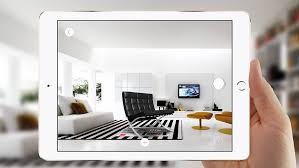3D Catalog for furniture
according to Centric Digital Augmented reality in retail study on US customers, furniture is the top product people want to shop with AR (60%). Other products include clothing (55%), groceries (39%), shoes (35%) and jewelry (25%). So even though the AR technology is not ultimately here yet, AR furniture shopping is already a thing known to customers.
How do AR apps work
Augmented Reality is a way of overlaying virtual animated objects onto real world surroundings using mobile devices. A live environment augmented by digital data – sounds, images, videos.
There are 2 groups of AR apps:
- Marker-based apps
- Location-based apps
First ones work with image recognition using camera to scan an image (marker) and then add a virtual image on the phone screen. For example, many apps read QR codes and present additional information.
Location-based AR apps use GPS to locate places nearby and/or to offer directions, etc.
The idea for using augmented reality apps is simple:
- Download the app
- Get the marker image/code/flyer
- Place the marker in your environment
- Point the device at the marker and interact with augmented reality
AR apps are mostly used in commerce, entertainment, games, retail, medicine.
Benefits of augmented reality in furniture
Overall, using augmented reality applications businesses can:
- Personalize shopping experiences
- Entertain and amaze customers
- Engage and retain customers
- Be ahead of competition
While customers can enjoy AR tools in such ways as:
- Find and try products remotely
- Explore brand new ways to shop
- Making more informed purchasing decisions
- Combine buying with entertainment
For furniture retailers, the approach of ‘try before you buy’ is crucial and this option for customers is a winning ticket. Offering this yet futuristic technology of AR is of news value alone, to begin with. The mere fact that a retailer has an AR app instantly gets the attention and potentially increase sales. To prove this point, a good example is GAP chain of stores, that opened up augmented dressing rooms, got big publicity and higher traffic to their website in result.
AR is also a fine tool for personalization of customer needs, especially when it comes to furniture. Shoppers really want the ability to see how the items will look at their homes or offices. IKEA was the first AR ice-breaking furniture company introducing the catalog app for these exact needs. A user takes a photo of a place with the app, browses the catalog and tries selected items onto a place.
How can AR in furniture help expand your business
Being on the forefront of modern technology, you can benefits from augmented reality in following ways:
Showcasing. Retailers are able to showcase their products visually and interactively with AR tools. A furniture store may offer customers to see how a table of a bed would look like in their house.
Beat competitors. With such advanced technology as AR you can compete and easily get ahead of competition. Offering innovative shopping experiences leads customers your way, no doubt about it.
Younger customers and swag (in a good sense). Augmented reality apps are trending among younger audience so why not use it as a new advertising option? And unlike Virtual Reality apps that require additional equipment, AR is more widely available, and there are literally millions of smartphone owners.
Trials free of risk. With an AR app people can place a bookshelf in their rooms in a few taps on a phone. Or see how a sofa would look in brown or red color. The risk of product return and logistical expenses is minimized.
New marketing opportunities. AR offers new ways to promote your brand, to offer product information, to present new products, to offer helpful 3D experiences to customers. And most importantly, to attract more customers.
FONTE https://thinkmobiles.com/





